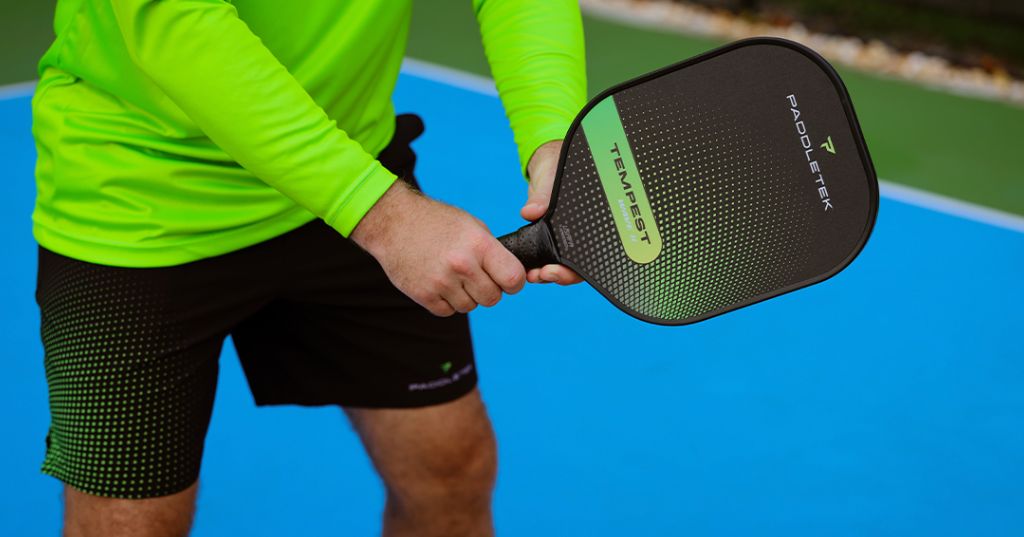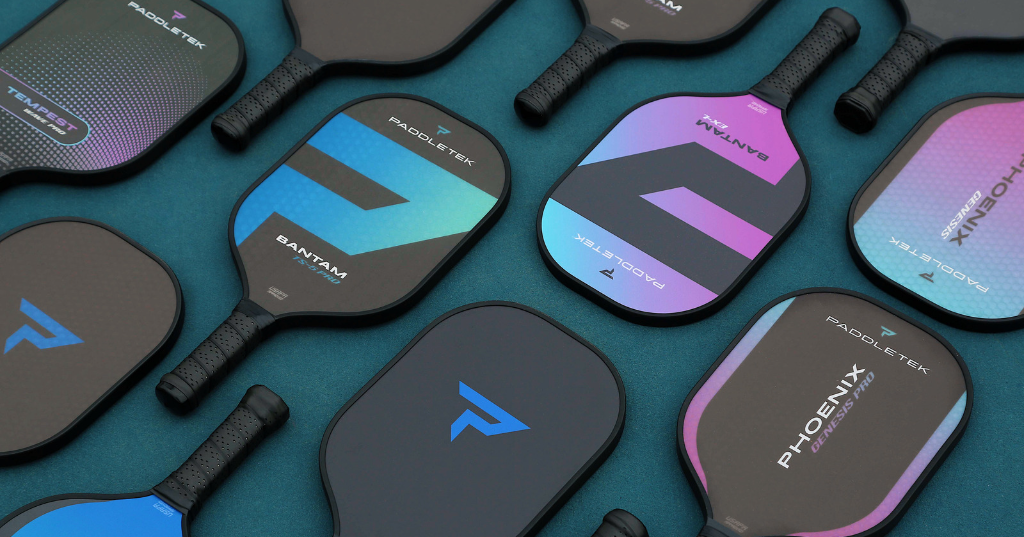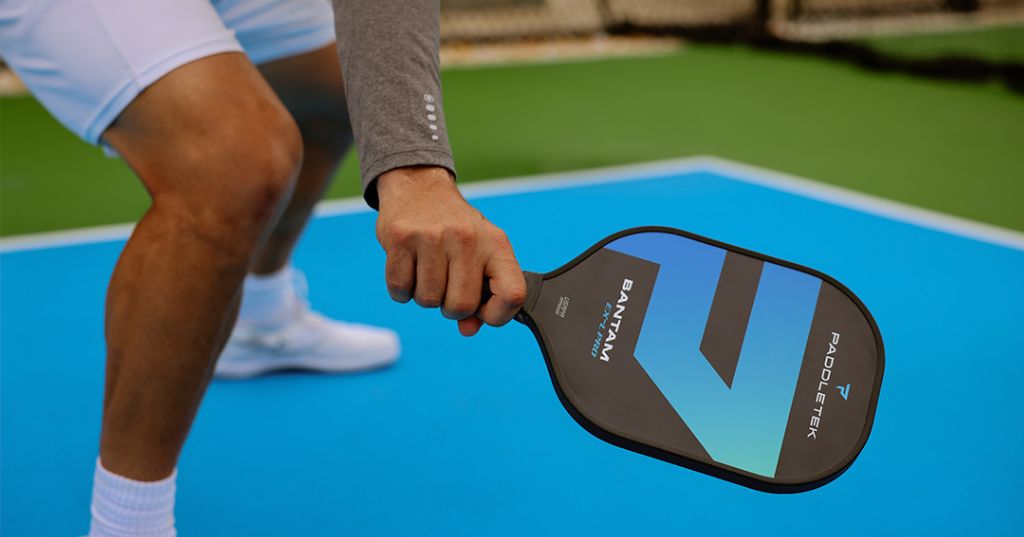No matter how you play pickleball, you won't climb the ladder without mastering the volley. This is true of singles but even more so for doubles since play often comes down to the kitchen and the net.
Controlling the kitchen is key to winning rallies, and volleys are one of the best ways to do that. So in the spirit of improving your game at the net, here are 9 tips to help you win the net:
- Maintain an athletic stance.
- Hold your line.
- Hold your paddle at 10 or 11 o'clock.
- Use the hammer grip to create a vertical angle.
- Adjust your grip pressure based on your court position.
- Swing from the shoulder, not the wrist.
- Don't swing behind your shoulder.
- Keep your volleys low.
- Don't respond to low volleys with power.
If only incorporating each tip was as easy as reading it off a list... Let's have a closer look at all 9 tips to improve your volleys. We'll cover all the details you need to successfully build these game-changing concepts into your volley game.
1. Athletic Stance - Improves Reaction Time
You can't volley without being able to get your paddle to the ball in time, and that's precisely where an athletic stance comes into play. The athletic stance consists of having your feet shoulder-width apart and facing forward, knees bent, a slight bend at the back, and your arms in a ready position.
This body position is ready to move in any direction so you can react to the incoming ball quicker, which helps you control your volley return.

2. Maintain Position at Kitchen Line - Reduces Gaps on Your Side
In a volley exchange, you need to maintain a defensive position that gives you the best chance of returning the ball without giving up space for your opponent to hit into. To do this, you want to stay behind your kitchen line but not move further back than that.
The instant you start retreating your opponent will land a soft shot right over the net, making it nearly impossible for you to get to in time.
3. Hold Your Paddle Pointing to 10 or 11 O'Clock - Faster Hands
Paddle speed is the name of the game, well pickleball is technically the name of the game, but being able to get your paddle to the right spot quickly might as well be the name of the volley game.
Imagine you're on a pickleball court and directly facing the center of the net. You have both your hands extended a foot or two in front of your body (which is where your hands should be in a ready position for volleying and dinking), and your dominant hand is holding the paddle. If your body is the spoke of an arm on a clock, then the center of the net is your 12 o'clock.
If you're right-handed, you want to rotate the tip of your paddle head somewhere around 10 to 11 o'clock - left-handed folks, you'll want to rotate the head of your paddle to somewhere between 1 and 2 o'clock.
This is the ideal position to hold your paddle for a few reasons. It's a good neutral position where you can quickly shift between forehand and backhand as needed, but by design, it favors your backhand. And that's because of how you hold the paddle with your backhand.
Your backhand requires you to move your arm across your body, so if someone sends a ball to your center, this is the quickest and best angle to respond from.
Each is instrumental in preventing your body from getting jammed up in play, while also making sure you can reach the ball in time.

4. Hammer Grip - Neutral Position
When you're at the kitchen line, you never know where or when the ball is going to reach you, this is why it's important to always be ready. This starts with the grip, and few are better for getting your hands ready for dinking and powerful backhands like the hammer grip.
Just like you'd imagine, the hammer grip (also called the continental grip) requires holding the paddle like it's a hammer so that the head of the paddle is nearly vertical. At a moment's notice you can dink volley with your forehand or backhand volley.
The vertical angle created by this grip is essential for blocking as well. Plus with a simple rotation of the grip you can go into an eastern grip which will serve you better for groundstrokes.
5. Adjust Grip Pressure - Creates Soft Hands
A great volley doesn't always start and end with great power. In most cases, a softer shot is going to be the preferred technique for accurately landing the volley. But based on where you're at on the court, you'll need to adjust the pressure of your grip to keep your shots soft yet still clear the net.
As a baseline for having a softer grip, think of your middle finger, ring finger, and pinky as how you just stabilize the paddle versus doing any lifting. Whereas your index finger and thumb are responsible for gripping your paddle.
If you were at the non-volley line, this would be the ideal pressure to keep soft hands on your volleys. The further you get back, you might try to add pressure by individual fingers or collectively.
Think of it this way, the tighter you grip, the more power you add. So the further away you are from the net, the more power you'll need to send it over. And since volleys are done in short condensed swings from your shoulders, your grip is the go-to for maintaining proper form while adding adequate power to the equation.
6. Swing from Your Shoulders - Maintains Control
When it comes to volleying, control is key. You don't want to hit the ball too hard or else your opponent will have an easy time returning it. You also don't want to rotate your entire body and then slingshot back to front. The paddle will create enough lift and power with a short swing to successfully volley.
Not only that, but if you decide to rely on wrist action to generate power, you'll lose control of placing the ball. It's an easy way to put too much power behind it on a path to nowhere.
7. Don't Pull Back - Governs Power and Control
If you're walking into a volley with the idea that you're going to do a full swing, you're going to gain way too much power and lose control in the process. It's better to think of it more as a push rather than a pull.
This means that your arm should start extended, almost stiff, and stay there during the entire motion. If you're doing this right, your elbow and wrist shouldn't move back at all as you contact the ball with your paddle. Just your shoulder is making the move.
If you reach beyond your shoulder line you've gone back way too far. An easy way to stick to this is to make sure you can see your entire paddle during every volley. If you can't see it, it's probably pulling back too far.

8. Volley Low - Forces Opponent Mistakes
The key to volleying is all about placement. The lower you can keep the ball, the more pressure it puts on your opponent, and the less likely they'll be able to return the shot. Not only that, but if you make contact with a low volley then it's more difficult for them to aim at a specific target.
Remember, a key strength of volleying is that it reduces the amount of time your opponent has to react to your shot. Combine this shorter window with key placements and you'll have shots that your court foe can't even get to.
9. Return Low Shots Softly - Prevents Trouble
If your opponent fires a low shot your way, your first reaction might be to return the favor with equal or more power, but you'll want to resist this urge for a few reasons.
You'll be contacting the ball from a low point, to begin with, which will already have a disadvantage with the correct angle to clear the net. So adding power to your shot instead of finesse is not the right tactic here.
Precision is what you need or else you'll send it right to the net or out of bounds with some gusto. And even your best scenario here would be putting it in a rally-winning position for your competitor.
So if you're trying to volley a push dink with some power, counter it with a soft shot, such as the drop volley. This is easily done by softening your grip, which allows your body to take some of the ball impact from your paddle and remove the energy that will push it off your volley.
That way, it will maintain a low trajectory and rise just enough to clear the net with room to spare. This not only puts you in control of your shot making but can also force some mistakes from your opponent if they're expecting something more powerful.
Use Volleys to Make Your Opponent Uncomfortable
Overall, these tips should help you sharpen up your volleys on the court and give you an edge against your opponent. Keep in mind that the key to volleying correctly is controlling the power and precision of the shot.
Volleying is a great way to take control of the point right away, make your opponent uncomfortable, and force some mistakes in the process. Just remember to keep it short, low, and precise and you'll be volleying with the best of them.




Leave a comment
This site is protected by hCaptcha and the hCaptcha Privacy Policy and Terms of Service apply.